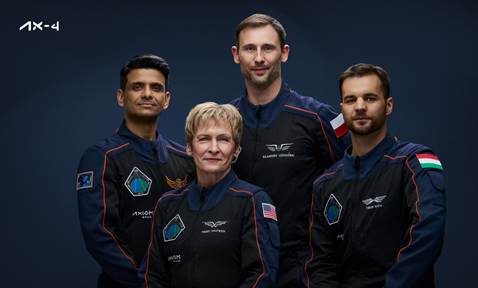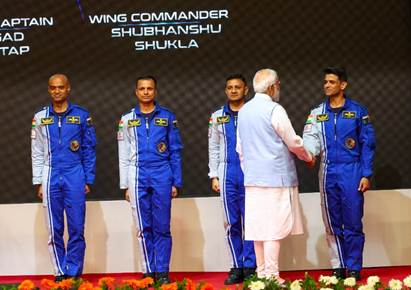Technology
Pioneering India’s Next Leap in Space
Posted On: 10 JUN 2025 4:03PM
Introduction

India stands on the brink of a historic leap in its space journey with Group Captain Shubhanshu Shukla of the Indian Air Force poised to become the first Indian astronaut in over four decades to travel to space. Selected under ISRO’s Human Spaceflight Programme (HSP), Shukla’s upcoming role as Mission Pilot on the Axiom Mission 4 (Ax-4) to the International Space Station (ISS) not only revives the legacy of Rakesh Sharma’s 1984 mission but also signals a bold new chapter in India’s ambitions beyond Earth. His mission is symbolic of the country’s growing technological confidence, global collaborations, and readiness to contribute meaningfully to the global space community.
Shubhanshu Shukla has been selected for Axiom Mission 4 and is one of the four Indian Air Force test pilots chosen for India’s Gaganyaan Mission.
At the heart of this mission lies more than symbolism. Shukla’s assignment will support cutting-edge experiments in space biology and life support systems, critical to sustaining human life in space while strengthening India’s capabilities. His participation reflects a broader transformation within India’s space programme, which now aims not only to explore but to lead.
Axiom Mission 4
The Axion Mission 4 will “realize the return” to human spaceflight for India, Poland, and Hungary, with each nation’s first government-sponsored flight in more than 40 years. While Ax-4 marks these countries' second human spaceflight mission in history, it will be the first time all three nations will execute a mission on board the International Space Station. This historic mission underscores how Axiom Space is redefining the pathway to low-Earth orbit and elevating national space programs globally.[1]

- Role: Shukla will serve as Mission Pilot on Ax-4, alongside an international crew led by Commander Peggy Whitson (USA). This mission, managed by Axiom Space and launched aboard a SpaceX Falcon 9 on June 11, will make Shukla the first Indian astronaut to visit the ISS.[2]
- Scientific Focus: The mission is notable for its emphasis on operational readiness and scientific experimentation. Shukla will conduct pioneering food and nutrition-related experiments, developed in collaboration between ISRO, the Department of Biotechnology (DBT), and NASA. These experiments are designed to advance knowledge in space nutrition and closed-loop life support systems, critical for future long-duration missions.[3]
- Biological Experiments: Two major experiments will be conducted:
- Microalgae Study: Investigating how microgravity and space radiation affect the growth and nutrient profile of edible microalgae, which are promising for sustainable space nutrition and oxygen production.[4]
- Cyanobacteria Research: Examining the growth and metabolic response of Spirulina and Synechococcus under microgravity, including the use of nitrogen sources derived from human waste. This research aims to develop self-sustaining life support systems for future space habitats.[5]
- Voyager Tardigrades: This ISRO project will investigate the revival, survival, and reproduction of tardigrades sent to the ISS. The project will examine the revival of dormant tardigrades, count the number of eggs laid and hatched during a mission, and compare the gene expression patterns of spaceflown vs. ground control populations. The research seeks to identify molecular mechanisms of resilience which has implications for understanding the limits of life in extreme environments. This knowledge could inform future space exploration and help develop biotechnology applications on Earth.
- Other research planned: Crop Seeds on ISS, Myogenesis, STEMonstrations, Sprouts, Voyager Displays.[6]
- Strategic Importance: The mission is designed to provide hands-on experience in spaceflight operations, microgravity adaptation, and emergency preparedness, all of which are essential for India’s upcoming indigenous human spaceflight missions, particularly Gaganyaan.[7]
India’s Space Achievements: Ambition to Leadership
India’s space programme, led by the Indian Space Research Organisation (ISRO), is undergoing a transformation marked by bold ambitions, technological innovation, and increasing global collaboration.
During the last ten years starting from January 2015 to December 2024, a total of 393 foreign satellites and 3 Indian customer satellites have been launched on commercial basis on-board ISRO’s PSLV, LVM3 and SSLV Launch Vehicles.
India has launched satellites of 34 countries so far, including those of developed countries since 2014 including- United States of America (232), United Kingdom (83), Singapore (19), Canada (8), Korea (5) Luxemburg (4), Italy (4), Germany (3), Belgium (3), Finland (3), France(3), Switzerland (2) Netherland (2), Japan (2), Israel (2), Spain (2), Australia (1), United Arab Emirates (1), Austria (1), etc.[8]
On 15 February 2017, ISRO launched 104 satellites in a single mission- an unbroken world record.
Gaganyaan Programme:
The Gaganyaan Programme was approved with a financial outlay of approximately ₹20,193 crore. It is India’s first indigenous human spaceflight initiative. It aims to send Indian astronauts to Low Earth Orbit (LEO), laying the foundation for more advanced missions. The vision has since expanded to include the establishment of the Bharatiya Antariksh Station (BAS) by 2035 and an Indian crewed lunar landing by 2040.[9]
This investment supports key technology development activities and a total of eight planned missions, including both uncrewed and crewed flights. Four Indian Air Force test pilots have been selected and have completed their physical, psychological, and generic spaceflight training-
- Gp Capt. PB Nair
- Gp Capt. Ajit Krishnan
- Gp Capt. Angad Pratap
- Gp Capt. S Shukla

They are set to become India’s first astronauts in independent spaceflight, marking a new chapter in national scientific achievement.
As of May 2025, the programme entered its final phase with the first human spaceflight now scheduled for the first quarter of 2027. Currently, the Human-rated LVM3 vehicle, the Crew Escape System, and the Crew Module and Service Module are all undergoing final stages of testing and integration, while training of astronauts is also progressing steadily.[10]
Scientific focus: Developing and validating technologies necessary for safe human spaceflight, along with laying the groundwork for advanced space science research in microgravity environments. The mission includes precursor and demonstration missions, which are essential for the future construction and operation of the Bharatiya Antariksh Station (BAS), India’s planned space station. These scientific objectives are closely aligned with India’s broader vision during Amrit Kaal, for space exploration, including operationalizing BAS by 2035 and launching a crewed lunar mission by 2040. Additionally, the program is expected to spur increased industrial participation and economic activity, generating employment, particularly in high-tech fields related to space and allied industries.[11] [12]
Strategic Importance:
- Technological Advancements and Spin-offs:
- New Technologies: The development of advanced technologies like cryogenic engines, lightweight materials, life support systems, and robotics will have applications in various industries, including aerospace, automotive, healthcare, and energy.
- Job Creation: The mission is expected to create numerous jobs in the aerospace industry, research institutions, and associated sectors.
- Economic Growth: The development of indigenous space technology will attract investments, boost domestic manufacturing, and contribute to economic growth.
- Inspiring Future Generations:
- STEM Education: The mission will inspire young minds to pursue careers in science, technology, engineering, and mathematics (STEM).
- National Pride: A successful human spaceflight program will enhance national pride and inspire a sense of achievement among the Indian populace.
- International Collaboration and Diplomacy:
- Global Partnerships: The mission will foster international collaborations with other spacefaring nations, leading to knowledge sharing and joint ventures.
- Diplomatic Influence: India's successful space program will enhance its global standing and diplomatic influence.[13]
Historic Milestones in Space Exploration:
- Aditya L-1: India’s first solar mission, Aditya L-1 was launched in 2017 and aimed at studying the Sun from an orbit around the Sun-Earth Lagrangian point 1 (L1) which is about 1.5 million kilometres from the Earth.[14] In February 2025, The Solar Ultraviolet Imaging Telescope (SUIT) onboard Aditya-L1 captured an unprecedented view of a powerful solar flare ‘kernel’ in the lower solar atmosphere, namely the photosphere and the chromosphere.[15]
- Chandrayaan-3 and Lunar Exploration: India became the first nation to reach the Moon’s southern pole, demonstrating technological prowess and global leadership in lunar science. Additionally, the Pragyan rover confirmed sulphur on the Moon using its LIBS instrument.

- Space Docking and Servicing: The SpaDeX mission, set for December 2024, will demonstrate India’s indigenous docking technology, vital for space station assembly and long-duration missions.
- Orbital Re-entry Vehicle: ISRO is developing a winged body Orbital Re-entry Vehicle (ORV), which will be launched into orbit using an ascent vehicle and subsequently re-enter into the earth’s atmosphere for an autonomous approach & landing on a runway.
International Collaborations:
- Missions like NISAR (with NASA) and Shukla’s participation in Ax-4 highlight India’s growing role in international space partnerships.
- ISRO is working with CNES (French National Space Agency) for realizing a joint satellite mission named ‘TRISHNA (Thermal Infrared Imaging Satellite for High Resolution Natural Resource Assessment)’, which is in the initial stages.
- ISRO and JAXA (Japan Aerospace Exploration Agency) have carried out a feasibility study to realize a joint lunar polar exploration mission.[16]
- In January 2025, ISRO and European Space Agency (ESA) entered into an agreement to cooperate on activities related to Astronaut Training, Mission Implementation and Research Experiments. This agreement provides an opportunity for undertaking joint microgravity experiments.[17]
Policy, Investment and Private Sector Growth
- 100% FDI: Under the amended FDI policy, 100% FDI is allowed in space sector. The liberalized entry routes under the amended policy are aimed to attract potential investors to invest in Indian companies in space. The entry route for the various activities under the amended policy are as follows:
- Upto 74% under Automatic route: Satellites-Manufacturing & Operation, Satellite Data Products and Ground Segment & User Segment. Beyond 74% these activities are under government route.
- Upto 49% under Automatic route: Launch Vehicles and associated systems or subsystems, Creation of Spaceports for launching and receiving Spacecraft. Beyond 49% these activities are under government route.
- Upto 100% under Automatic route: Manufacturing of components and systems/ sub-systems for satellites, ground segment and user segment.[18]
- India Space Policy 2023: In pursuance of the vision set out for the space sector, the India Space Policy was launched to pursue a holistic approach by encouraging and promoting greater private sector participation in the entire value chain of the Space Economy, including in the creation of space and ground based assets.[19]
- Space Vision 2047: India’s long-term roadmap includes the BAS, lunar landings, next-generation launch vehicles, and missions to Venus, all underpinned by the Space Vision 2047 strategy.[20]
- Central Public Sector Enterprises in the Space sector-
- Antrix Corporation Limited: ACL is ISRO’s commercial arm established in 1992, markets India’s space products and technologies globally. It offers end-to-end satellite solutions, launch services, remote sensing data and consultancy to international clients.[21]
- NewSpace India Limited (NSIL): NSIL is the commercial arm of ISRO, promotes and commercializes Indian space products and services while enabling Indian industries to undertake high-tech space activities, leveraging ISRO’s expertise and heritage.[22]
- In-SPACe: IN-SPACe, established in June 2020 as an autonomous nodal agency under the Department of Space, serves as a single-window facilitator for private sector participation in all space activities. It promotes, authorizes, and supervises non-government entities in building launch vehicles, satellites, and providing space-based services. [23]
- Growing Investments and Mission Success
- Over the last 11 years, ISRO has completed 100 space launch missions.
- Budget: The space budget has nearly tripled over the past decade from 5,615 crores in 2013-14 to 13,416 crores in 2025-26, reflecting strong government commitment.[24]
- The SpaDeX (Space Debris Experimental) Mission is a new initiative to address the rising challenge of space debris in Earth’s orbit.
- Reforms and Innovation: The opening of the space sector to private players, establishment of a dedicated venture capital fund, and new policies have fostered a vibrant ecosystem, catalyzing innovation and job creation.[25]
- 328+ space startups have emerged in recent years.
- These startups are playing a crucial role in expanding India’s space innovation ecosystem, working alongside ISRO and other partners.
Conclusion
India’s space programme stands at a defining moment in its history, as it transitions from a journey of exploration to a mission of leadership. Group Captain Shubhanshu Shukla’s pioneering role aboard Axiom Mission 4 is more than a personal milestone, it is a national triumph that reflects India’s evolving capabilities and global stature in space science. Through cutting-edge research, strategic partnerships, and a robust vision encapsulated in initiatives like Gaganyaan and the Bharatiya Antariksh Station, India is laying the groundwork for a sustained human presence in space. The convergence of policy reforms, private sector participation, and technological ambition ensures that the space sector will not only drive scientific progress but also fuel innovation and economic growth. As India prepares for its first independent human spaceflight and ventures towards the Moon and beyond, it signals to the world that the future of space will be shaped by nations that dare to dream and have the resolve to act, and India is firmly among them.
References:
Click here for pdf file
***
Santosh Kumar/ Sheetal Angral/ Kritika Rane
(Backgrounder ID: 154615)
Visitor Counter : 60